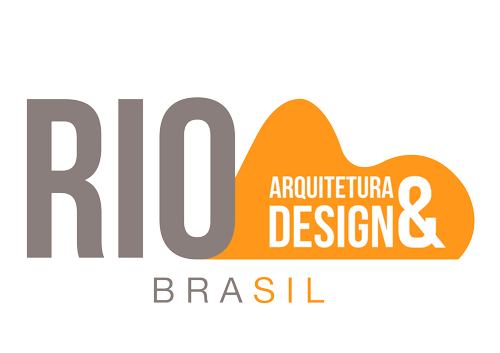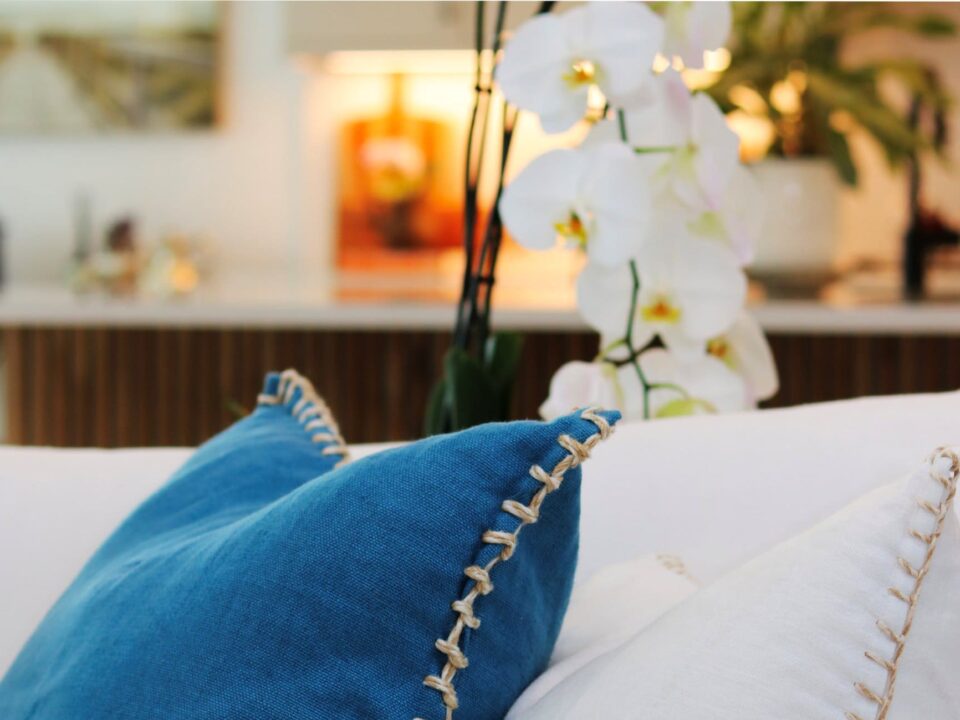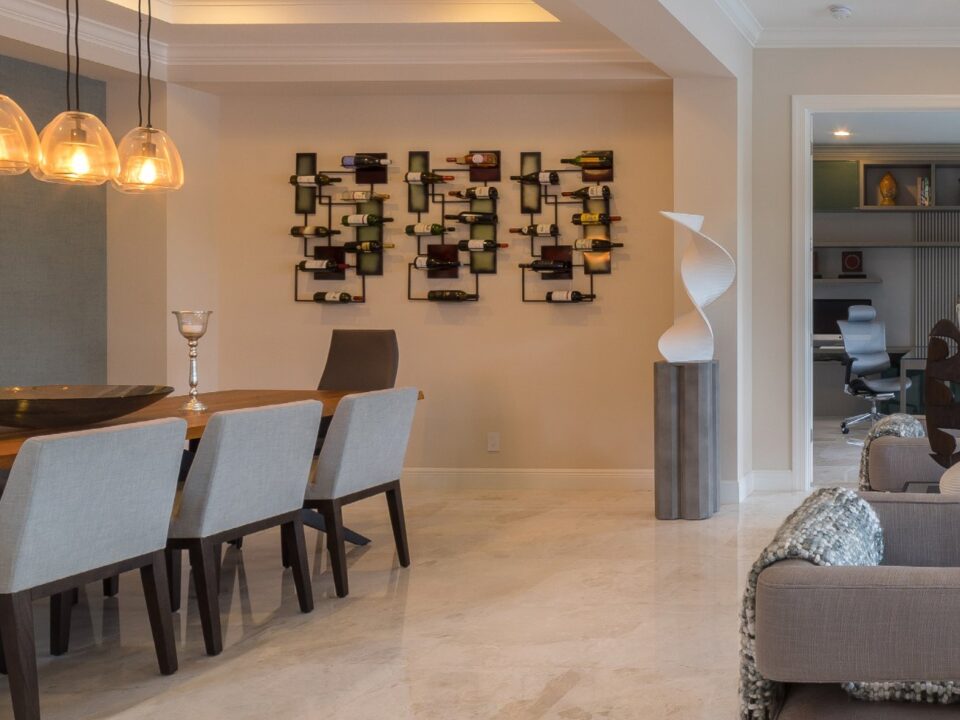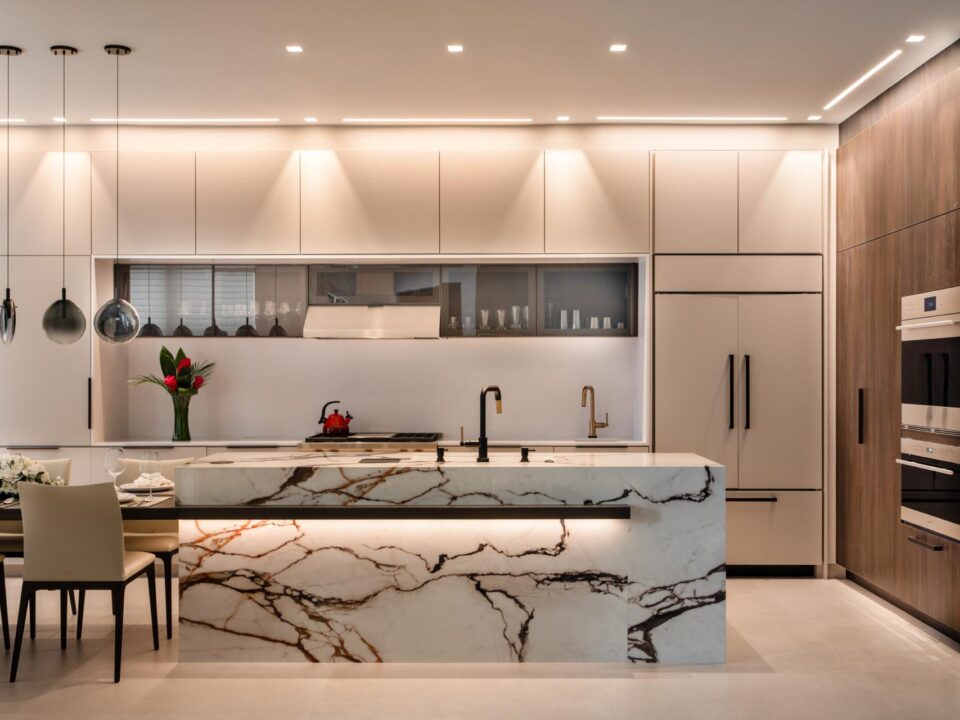
A arquitetura brasileira rompendo fronteira
13 de novembro de 2020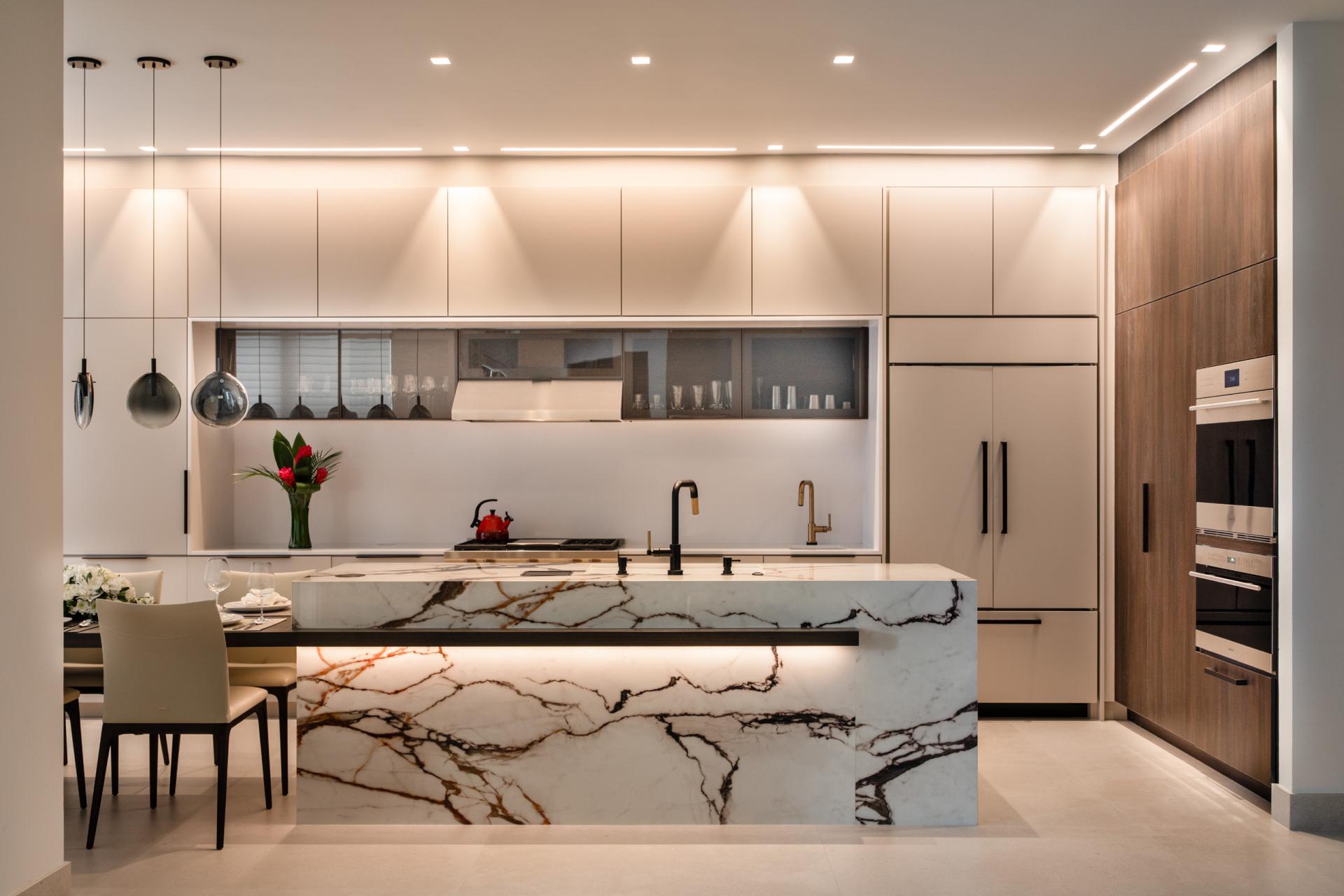
Arquitetura de Interiores na Flórida
21 de outubro de 2023Vemos como o projeto de uma casa se tornou um exemplo da importância de trabalhar com bons profissionais
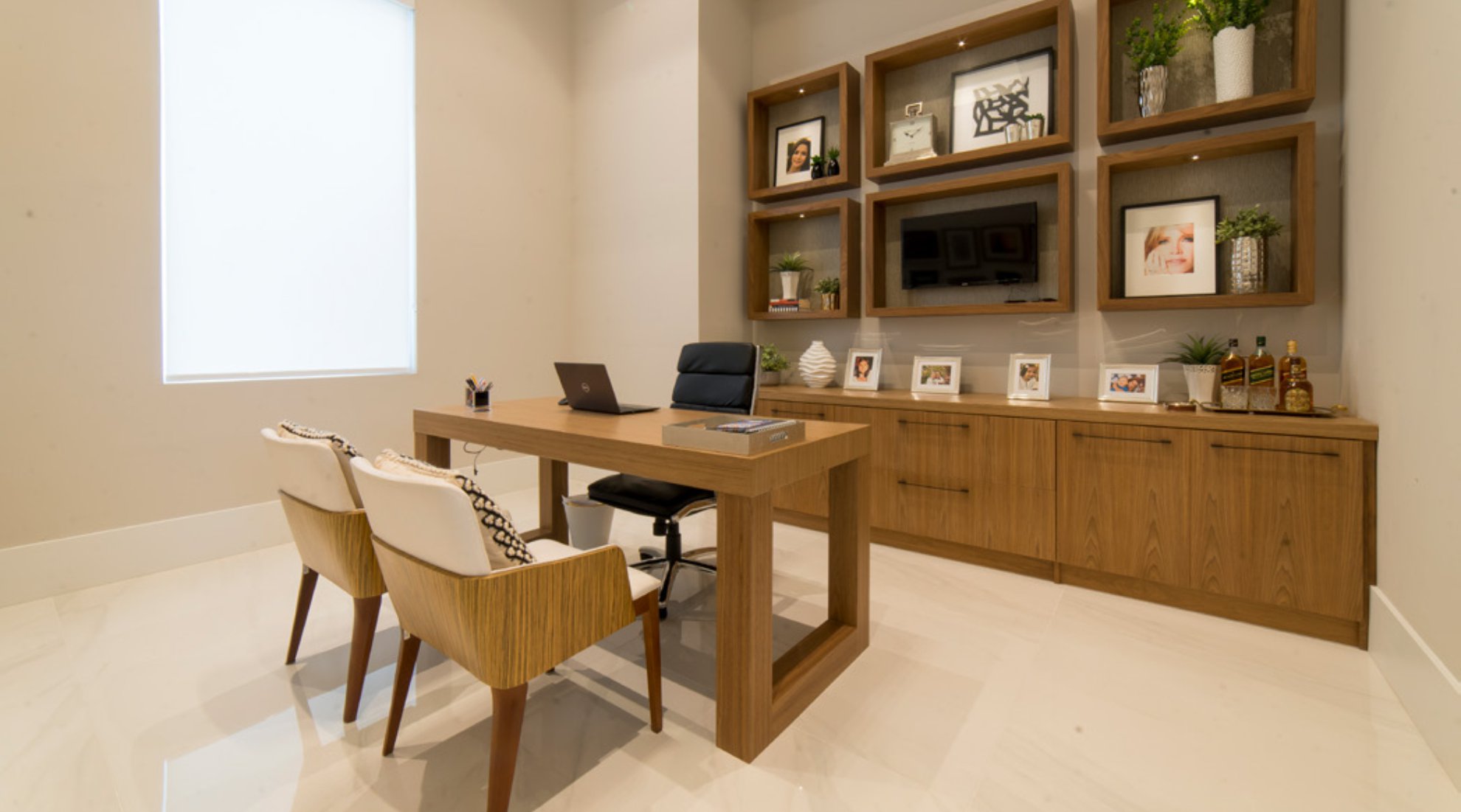
A
o sentir a necessidade de renovar e adaptar uma casa construída há mais de 18
anos, em codominio de luxo, com vista
para o lago, uma família brasileira residindo nos
Estados Unidos entregou a tarefa em mãos de
confiança. Somando o experiencia do empreendedor Marco Oliveri, com a criatividade da arquiteta
Renata Sallowicz, e o talento do designer de móveis Freddy Meyer em lidar com móveis planejados
de alto padrão, o resultado não poderia ser outro
além de um espetáculo visual e funcional.
Formada em arquitetura ainda no Brasil a arquiteta sempre quis focar sua atuação em design e decoração e após 18 anos da sua mudança para os
Estados Unidos iniciou seu proprio negocio, atendendo seus clientes do sul da Florida. Neste projeto,
Renata levou em consideraco aspectos individuais
desta família, como as necessidades de três jovens
meninas e um casal que se dedicada ao home office, alem de espacos amplos de entretenimento para
acomodar todas as obras de artes e móveis trazidos
do Brasil pela família.
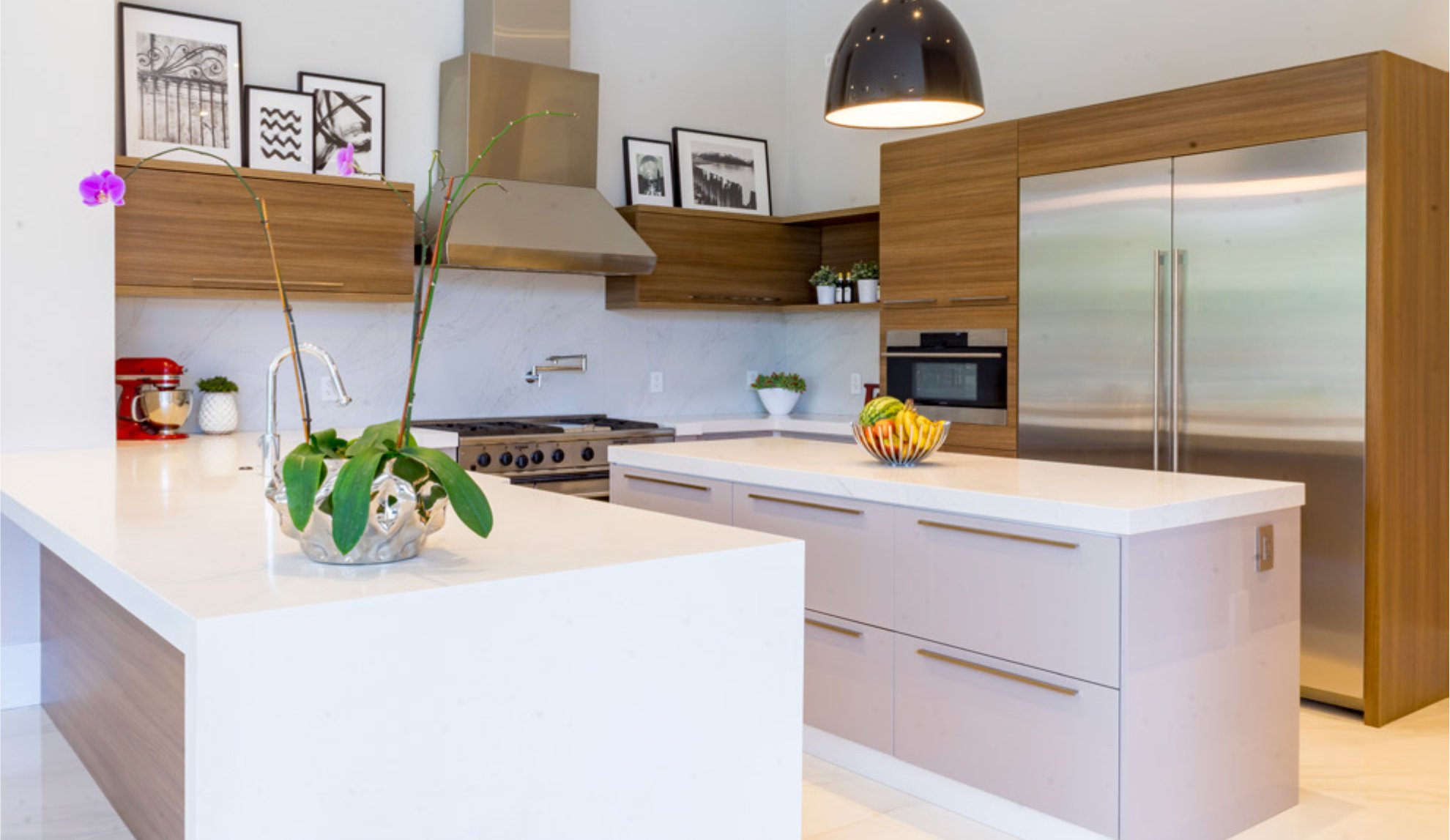
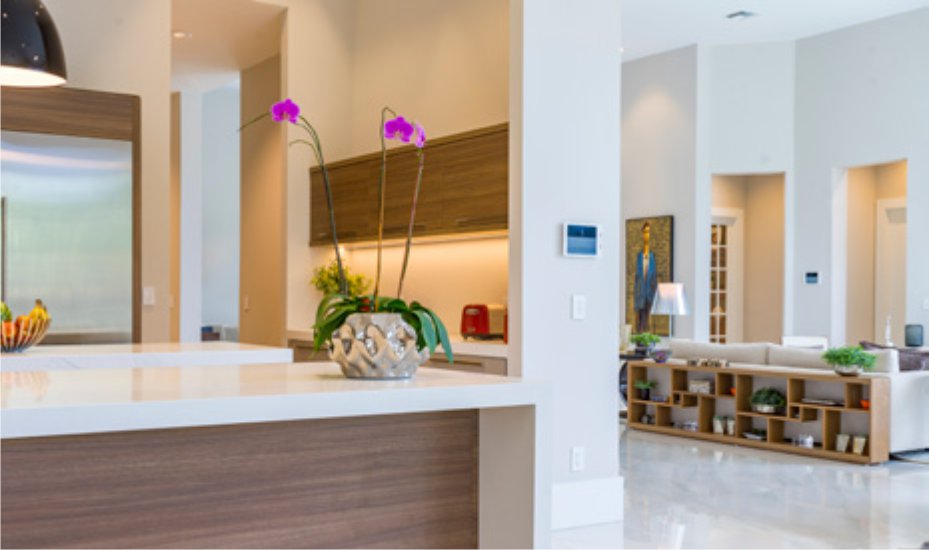
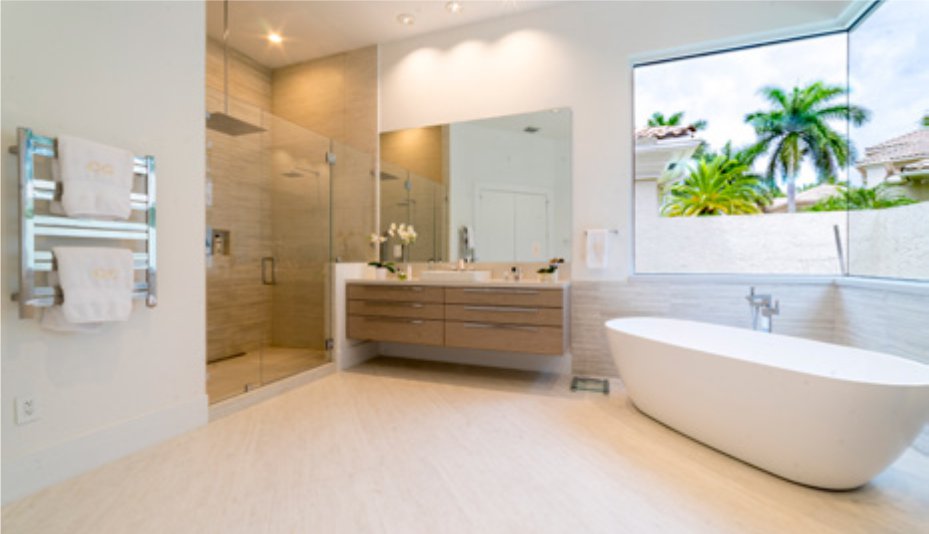
Situada em Miami, Flórida, a Ebano USA é uma loja
exclusiva. Trabalhando com customização de marcenaria do mais alto padrão, a empresa é reconhecida
por oferecer projetos absolutamente personalizados
aos gostos e necessidades de seus clientes.
Além da parceria entre Renata e Freddy, o projeto teve a inserção da experiência no processo executivo de Marco Olivieri da MRK GC Construction & Remodeling Group, adicionando porcelanatos europeus 48”x 48” (1,20m x 1,20m) inovação que requer conhecimento e expertise para uma instalação de qualidade. Além disso, porcelanatos 3D foram instalados pela MRK GC, dando um toque descontraído e, ao mesmo tempo, inesperado nos banheiros das suítes das três meninas.
O banheiro da suíte principal com design em linhas limpas e tons naturais, executado com perfeição pela MRK GC, com acabamento em porcelanato fosco para o piso e texturizado nas paredes - que receberam gabinetes folheados em madeira carvalho claro executados pela Ebano USA, elevando a estética do ambiente à um novo nível. Todo o processo da obra durou cerca de 5 meses e resultou em um projeto de enorme sucesso que serve como espelho para trabalho de diversos outros profissionais. De nada adianta beleza se você não tem qualidade, confiança e um espaço que funciona junto das tarefas da família. Graças a junção de três incríveis profissionais, o projeto saiu dos sonhos, direto para a vida dos seus moradores.
Além da parceria entre Renata e Freddy, o projeto teve a inserção da experiência no processo executivo de Marco Olivieri da MRK GC Construction & Remodeling Group, adicionando porcelanatos europeus 48”x 48” (1,20m x 1,20m) inovação que requer conhecimento e expertise para uma instalação de qualidade. Além disso, porcelanatos 3D foram instalados pela MRK GC, dando um toque descontraído e, ao mesmo tempo, inesperado nos banheiros das suítes das três meninas.
O banheiro da suíte principal com design em linhas limpas e tons naturais, executado com perfeição pela MRK GC, com acabamento em porcelanato fosco para o piso e texturizado nas paredes - que receberam gabinetes folheados em madeira carvalho claro executados pela Ebano USA, elevando a estética do ambiente à um novo nível. Todo o processo da obra durou cerca de 5 meses e resultou em um projeto de enorme sucesso que serve como espelho para trabalho de diversos outros profissionais. De nada adianta beleza se você não tem qualidade, confiança e um espaço que funciona junto das tarefas da família. Graças a junção de três incríveis profissionais, o projeto saiu dos sonhos, direto para a vida dos seus moradores.

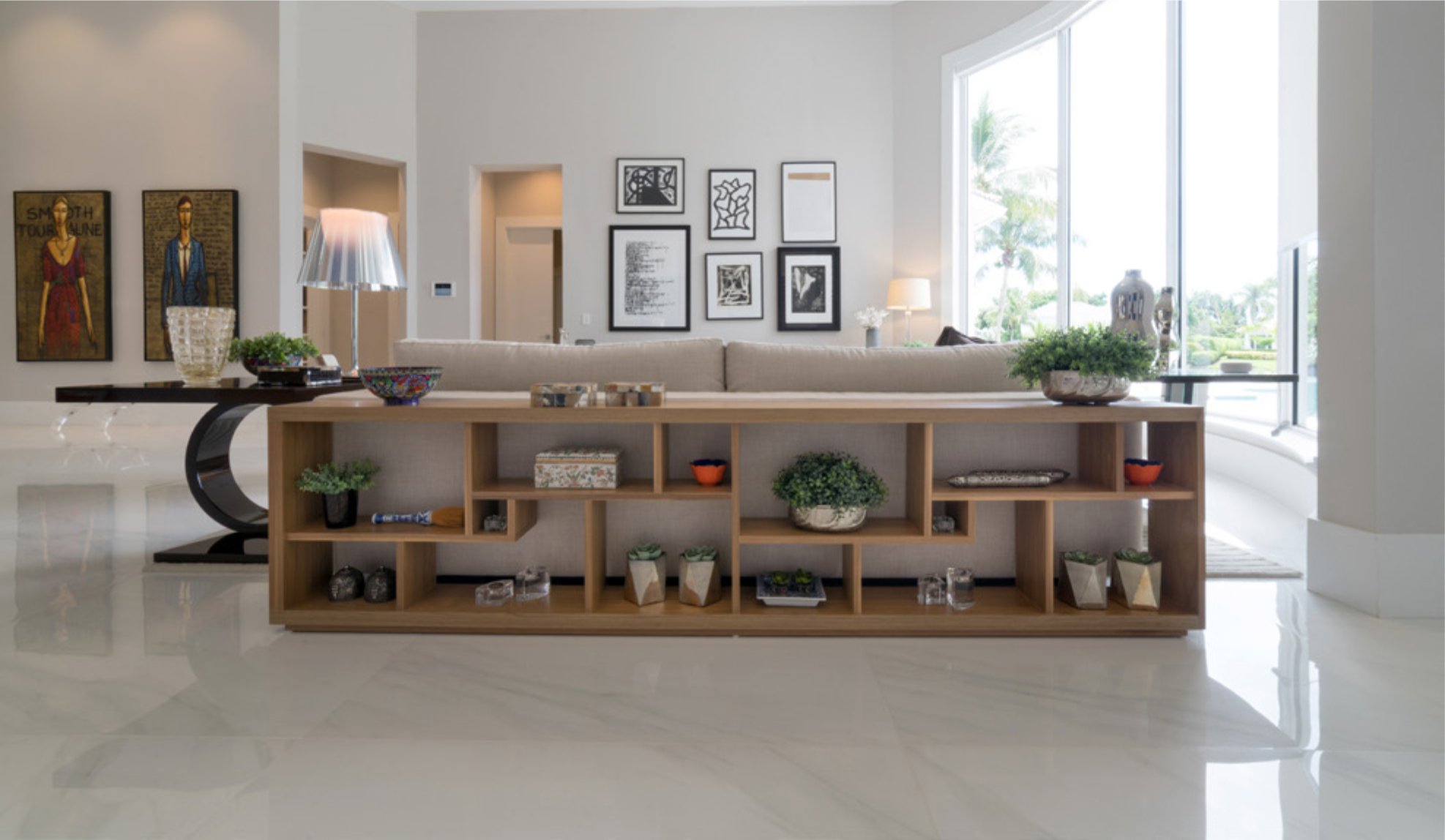
Um aparador áureo
Como o Designer de Móveis Freddy Meyer idealizou um aparador que praticamente se construiu sozinho
A explicação geométrica da chamadaProporção áurea pode ser enfadonha
para o leigo, mas o resultado visual de
tudo que se insere nesta lógica parece
ser universalmente definido como belo.
Também conhecida como “Razão Áurea”, “Razão de ouro” e outros nomes, a proporção áurea não foi criada por um Homem. Ela foi, no máximo, decodificada em uma aproximação decimal de 1,618 pelo matemático italiano Fibonacci nos ombros de vários outros gênios como os gregos Phidias, Platão e Euclides, que jáhaviam notado uma uniformidade geométrica presente em tudo que é ligado à natureza.
A altura de um corpo humano inteiro, dividido pela altura do umbigo ao pé?Razão áurea. A medida do ombro à ponta do dedo, dividida pela distância entre ocotovelo e a ponta do dedo? Idem. Até a distância entre os galhos de uma árvore se dá através desta fórmula.
O enigma por trás deste número de ouro encontrado em tantas “obras de Deus”, fez com que muitos artistas seusassem desta lógica para instantaneamente produzirem obras globalmenteaceitas como belas. E foi testando esta teoria que o designer de móveis Freddy Meyer fez este distinto aparador, com seus nichos todos desenhados à partir da sequência de Fibonacci.
“A obra já tinha acabado, e a cliente pediu para adicionar um aparador.Eu estava relendo alguns estudos do Fibonacci e pensei: por que não aplicar a razão áurea e fazer com que o aparador fosse mais do que apenas algo para pôr atrás do sofá? Fosse uma peça útil tantono armazenamento de objetos, como nadecoração da sala em si? E foi impressionante como o móvel quase que se auto -criou: peguei a medida atrás do sofá, fui utilizando o número de ouro pra produziros retângulos e automaticamente as outras partes foram se formando e encaixando, alcançando, na minha opinião, umequilíbrio visual belíssimo.”
Não satisfeito, o designer de móveis ainda se usou de todo o mistério sedutor por trás do “número de ouro” e elevou à um novo nível a idéia de exclusividade desua empresa Ebano USA: deixou um segredo - que ele não quis revelar, pois nãosabe se o cliente até hoje o encontrou - escondido em algum lugar do móvel. Onde estará? Veja as fotos desta obra de arte; quem sabe você não o descobre e decodifica?
Também conhecida como “Razão Áurea”, “Razão de ouro” e outros nomes, a proporção áurea não foi criada por um Homem. Ela foi, no máximo, decodificada em uma aproximação decimal de 1,618 pelo matemático italiano Fibonacci nos ombros de vários outros gênios como os gregos Phidias, Platão e Euclides, que jáhaviam notado uma uniformidade geométrica presente em tudo que é ligado à natureza.
A altura de um corpo humano inteiro, dividido pela altura do umbigo ao pé?Razão áurea. A medida do ombro à ponta do dedo, dividida pela distância entre ocotovelo e a ponta do dedo? Idem. Até a distância entre os galhos de uma árvore se dá através desta fórmula.
O enigma por trás deste número de ouro encontrado em tantas “obras de Deus”, fez com que muitos artistas seusassem desta lógica para instantaneamente produzirem obras globalmenteaceitas como belas. E foi testando esta teoria que o designer de móveis Freddy Meyer fez este distinto aparador, com seus nichos todos desenhados à partir da sequência de Fibonacci.
“A obra já tinha acabado, e a cliente pediu para adicionar um aparador.Eu estava relendo alguns estudos do Fibonacci e pensei: por que não aplicar a razão áurea e fazer com que o aparador fosse mais do que apenas algo para pôr atrás do sofá? Fosse uma peça útil tantono armazenamento de objetos, como nadecoração da sala em si? E foi impressionante como o móvel quase que se auto -criou: peguei a medida atrás do sofá, fui utilizando o número de ouro pra produziros retângulos e automaticamente as outras partes foram se formando e encaixando, alcançando, na minha opinião, umequilíbrio visual belíssimo.”
Não satisfeito, o designer de móveis ainda se usou de todo o mistério sedutor por trás do “número de ouro” e elevou à um novo nível a idéia de exclusividade desua empresa Ebano USA: deixou um segredo - que ele não quis revelar, pois nãosabe se o cliente até hoje o encontrou - escondido em algum lugar do móvel. Onde estará? Veja as fotos desta obra de arte; quem sabe você não o descobre e decodifica?
The geometric explanation of the socalled Golden Ratio may be boring for the
layman, but the visual result of everything
that fits this logic seems to be universally
defined as beautiful.
Also known as the “Golden Rectangle”, the golden ratio was created by nature, not by man. It was, at most, decoded to a decimal approximation of 1.618 by the Italian mathematician Fibonacci on the shoulders of such scholars as Phidias, Plato and Euclid,who had already noticed a geometric uniformity present in all that is linked to nature.
The height of the human body, dividedby the height from foot to navel? The Golden ratio. The measurement from shoulderto fingertip, divided by the distance between elbow and fingertip? The Golden ratio. Even the distance between the branch- es of a tree gives us the same ratio.
The enigma behind this golden number found in so many “works of God” hascaused many artists to use this logic to instantly produce globally accepted works ofbeauty. And it was testing this theory that furniture designer Freddy Meyer made this distinctive sideboard, with its niches all drawn from the Fibonacci sequence.
“The work was already finished, and the client asked to add a sideboard. I was re-reading some studies of Fibonacci and thought: why not apply the golden ratio andmake the sideboard more than just something to put behind the sofa? What if it wasuseful for storing objects while decorating the room itself? And it was impressive howthe piece of furniture almost created itself: I measured the space behind the sofa, used the golden number to create the rectangles and automatically the other parts formed and fit together, achieving, in my opinion, a beautiful visual balance”.
Not satisfied, the furniture designer used the seductive mystery of the “golden number” to raise the project to a new level.He left a secret - which he didn’t want to reveal because he doesn’t know if the clienthas found it until today - hidden somewhere in the furniture. The secret echoes one of the core goals of the designer’s company, Ebano USA: exclusivity in each piece and for each client. Where is the secret? Look at the photos of this work of art; who knows if you won’t find it and decode it?
Also known as the “Golden Rectangle”, the golden ratio was created by nature, not by man. It was, at most, decoded to a decimal approximation of 1.618 by the Italian mathematician Fibonacci on the shoulders of such scholars as Phidias, Plato and Euclid,who had already noticed a geometric uniformity present in all that is linked to nature.
The height of the human body, dividedby the height from foot to navel? The Golden ratio. The measurement from shoulderto fingertip, divided by the distance between elbow and fingertip? The Golden ratio. Even the distance between the branch- es of a tree gives us the same ratio.
The enigma behind this golden number found in so many “works of God” hascaused many artists to use this logic to instantly produce globally accepted works ofbeauty. And it was testing this theory that furniture designer Freddy Meyer made this distinctive sideboard, with its niches all drawn from the Fibonacci sequence.
“The work was already finished, and the client asked to add a sideboard. I was re-reading some studies of Fibonacci and thought: why not apply the golden ratio andmake the sideboard more than just something to put behind the sofa? What if it wasuseful for storing objects while decorating the room itself? And it was impressive howthe piece of furniture almost created itself: I measured the space behind the sofa, used the golden number to create the rectangles and automatically the other parts formed and fit together, achieving, in my opinion, a beautiful visual balance”.
Not satisfied, the furniture designer used the seductive mystery of the “golden number” to raise the project to a new level.He left a secret - which he didn’t want to reveal because he doesn’t know if the clienthas found it until today - hidden somewhere in the furniture. The secret echoes one of the core goals of the designer’s company, Ebano USA: exclusivity in each piece and for each client. Where is the secret? Look at the photos of this work of art; who knows if you won’t find it and decode it?
The Talent Mix
We see how the design of a house has become an example of the importance of working with good professionals
R
ecognizing the need to renovate and adapt a
home two decades old, a Brazilian family livingin the US put the task into safe hands. The renovation was carried out by a team made of experts:
the experienced entrepreneur Marco Oliveri, the creative architect Renata Sallowicz and the talented furniture
designer Freddy Meyer. The result? A graceful marriage
of visual aesthetics with practical functionality.
Architect Renata Sallowicz always wanted to focus her work on design and decoration, and chose to launch her own studio after eighteen years living in the United States. In this project, Renata took into consideration the individual aspects of the client’s family, so that the space could accommodate the needs of the three young girls in addition to a couple working from home. The house now also holds entertainment spaces featuring the artwork and furniture brought by the family from Brazil.
Located in Miami, Florida, Ebano USA provides a line of exclusive furniture. Working with custom carpentry of the highest standard, the company is renowned for offering completely customized projects that match the preferences and needs of its clients. Then, in addition to the partnership between Renata and Freddy, the project also benefited from the experience of Marco Olivieri of the MRK GC Construction & Remodeling Group, who added European 48”x 48” (1,20m x 1,20m) porcelain tiles, an innovation that requires knowledge and expertise for a quality installation. In addition, 3D porcelain tiles were installed by MARK GC, giving a relaxed and unexpected touch to the suites of the three girls.
The bathroom of the main suite features clean lines and natural tones, perfectly executed by MARK GC, with a frosted porcelain finish on the floor tiles and textured walls holding cabinets with a light oak cap moulding executed by Ebano USA, raising the aesthetics of the environment to a whole new level.
The whole process of the construction lasted some 5 months and resulted in a project of enormous success that serves as a mirror for the work of several other professionals. Aesthetics is always contingent on quality, confidence, and the coherence of a space working for the needs of the family. Thanks to the union of these three incredible professionals, this vision became a reality for its residents.
Architect Renata Sallowicz always wanted to focus her work on design and decoration, and chose to launch her own studio after eighteen years living in the United States. In this project, Renata took into consideration the individual aspects of the client’s family, so that the space could accommodate the needs of the three young girls in addition to a couple working from home. The house now also holds entertainment spaces featuring the artwork and furniture brought by the family from Brazil.
Located in Miami, Florida, Ebano USA provides a line of exclusive furniture. Working with custom carpentry of the highest standard, the company is renowned for offering completely customized projects that match the preferences and needs of its clients. Then, in addition to the partnership between Renata and Freddy, the project also benefited from the experience of Marco Olivieri of the MRK GC Construction & Remodeling Group, who added European 48”x 48” (1,20m x 1,20m) porcelain tiles, an innovation that requires knowledge and expertise for a quality installation. In addition, 3D porcelain tiles were installed by MARK GC, giving a relaxed and unexpected touch to the suites of the three girls.
The bathroom of the main suite features clean lines and natural tones, perfectly executed by MARK GC, with a frosted porcelain finish on the floor tiles and textured walls holding cabinets with a light oak cap moulding executed by Ebano USA, raising the aesthetics of the environment to a whole new level.
The whole process of the construction lasted some 5 months and resulted in a project of enormous success that serves as a mirror for the work of several other professionals. Aesthetics is always contingent on quality, confidence, and the coherence of a space working for the needs of the family. Thanks to the union of these three incredible professionals, this vision became a reality for its residents.
Ebano USA +1 (786) 828-7195
Renata Sallowicz +1 (717) 512-9246
Marco Olivieri +1 (754) 777-2729

